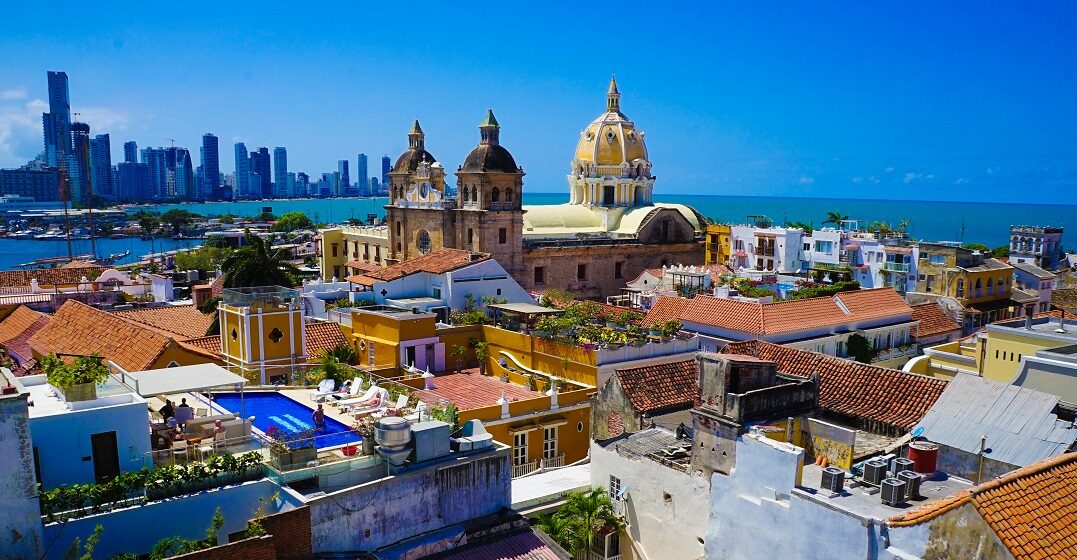Updated on August 7, 2023

Easy guide for moving to Colombia from the US

Considering moving to Colombia? It’s an excellent place to live for anyone looking to learn or improve their Spanish. What’s more, Colombia offers a generous visa for US remote workers looking to stay for longer than 90 days. You’ll have plenty of opportunities to immerse yourself in the vibrant Colombian culture and explore the diverse communities, accents, nature and food that Colombia has to offer. This easy guide explains exactly how to move to Colombia from the USA.
Let’s begin with some basic information and facts about Colombia as a country. A gateway to South America, Colombia has coastlines on both the Caribbean Sea and Pacific Ocean. The country borders, from east to west, Peru, Ecuador, Panama, Venezuela and Brazil. Named after Christopher Columbus, this nation declared independence from Spain on July 20th, 1810.
Colombia has six distinct natural geographic regions: Pacific, Caribbean, Andean, Amazonian, Orinoco and Insular (islands). The weather varies in these regions.
The majority of the country’s population lives in the Andean region, in cities like Medellín, Cali and Bogotá. These cities are at a higher elevation and usually remain cooler than those in other regions. In Medellín and Cali, temperatures are comfortable year-round and typically fluctuate between 60° and 80° Fahrenheit. Bogotá also stays relatively cool and can get as cold as 50° in December.
On the Caribbean coast, however, in cities like Cartagena and Barranquilla, the weather tends to be hotter (80°F and up) and humid with little variation throughout the year. The rainy season stretches from May to November and the dry season goes from December to April.
When it comes to working in Colombia, foreigners have two basic options: work remotely or work for a local company. These two options are determined, in part, by visa requirements in Colombia.
For native English speakers looking to work locally in Colombia, a good option is to teach English at a language academy, private school or university. Although not required, a CELTA or TEFL will open up more job prospects.
Spanish (or “Castellano,” as described in the Colombian constitution) is the official language of Colombia. Colombian Spanish has its own characteristics that set it apart from the Spanish spoken in other Spanish-speaking nations.
Luckily for Spanish language learners, the Colombian accent is generally considered one of the easiest for foreigners to understand. With that said, Colombia has at least as many accents as regions — and probably quite a bit more. Some distinguishing characteristics of the typical Colombian accent include:
Colombia is also home to many indigenous and Afro-descendant people who speak their own languages. Over 65 official indigenous languages are spoken across Colombia. There are two Creole languages spoken by Afro-descendant people on the Caribbean coast and the islands of San Andrés, Providencia and Santa Catalina. There is also a Romani language spoken by descendants of Romani immigrants.
Apart from a sense of adventure and a plane ticket, you’ll need a visa to move to Colombia. If you stay for less than 90 days, a visa is not required for US citizens. To stay longer than that, there are three types of visa: V (visitor), M (migrant) and R (resident). Let’s focus on the requirements for the V-type “digital nomad” visa. To get one, you will need to provide:
The application process can be carried out at any of the Colombian consulates around the world. Visa requirements can change often, so check the Colombian Cancellaría website for up-to-date information.
When it comes to where to live in Colombia, there are plenty of options.
Gentrification rapidly inflates the cost of living, driving locals out of their own neighborhoods. As a person from the US, one of the richest nations on earth, you may wish to minimize any negative impact you have when living in a new community abroad. The best way to do that is to be conscientious about where and how you spend your money. Here are a few tips:
A major pet peeve for Colombians is when foreigners misspell their country’s name. Remember: There is no “u” in Colombia. Once you have that down, moving to Colombia can be as straightforward and accessible as your research makes it. With its tremendous diversity and culture, Colombia has something for everyone. Immerse yourself in Spanish and Colombian culture, and try to minimize your negative impact. You’ll be mingling with locals in no time!